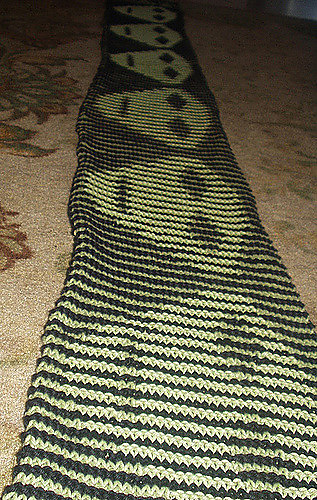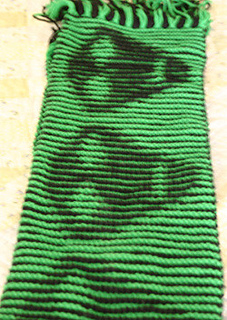patterns >  Stitch 'N Bitch: The Knitter's Handbook
Stitch 'N Bitch: The Knitter's Handbook
> Alien Illusion Scarf

Alien Illusion Scarf
Pattern Description from Stitch ‘n Bitch: “Illusion knitting was brought to my attention through an online knitting community. Most illusion patterns, however - typically hidden hears or secret x’s and o’s - were a bit too cutesy for knitters out there today. Once I figured out how it worked, I realized that any knitter who know the technique can crate his or her own illusion design. As proof of this, I created the alien illusion motif. Not you see him, now you don’t! The illusion is the result of two things: knitting texture and positive/negative space images. The texture is created by combining knit (flat) with purl (raised) stitches. In order to create the texture, it’s necessary to knit at a fairly tight gauge, but not so tight as to affect the drape of the fabric. Illusion motifs are done with two colors: the positive image color (green in this case) and the negative image, or background, color (black in this case). The image is then created in ‘slices,’ and each slice consists of four rows: two knit in the negative color and two in the positive color. Within these rows, the stitches that make up the image (a green alien head on a black background), are made with purl stitches. When the scarf is viewed from an angle, only the raised purl stitches are seen, and the images emerges. Spooky!”
Size: Approx 7” x 86,“ including fringe
Skills: Cast on, knit, purl, change color, read chart, bind off
Materials:
- Brown Sheep Company Nature Spun Worsted (100% wool; 100g/245yds)
- MC: 1 skein #601 Pepper
- CC: 1 skein #109 Spring Green
- US 7 (4.5mm) knitting needles, or size needed to obtain gauge
- Crochet hook for attaching fringe
Pattern on pages 160-161.
Note from Stitch ‘n Bitch: “Because there are only two rows worked in each color, the colors can be carried up the side of the scarf. It’s important not to pull these stitches to tightly or that edge of the scarf may be shorter than the opposite edge.”
Note: “In early printings of the book, the colors in the chart are reversed. The first two rows of the chart should be knit in the Contrast Color (green), the next two in the Main Color (black), and so on.”
Low Vision: This book is available from the National Library Service for the Blind and Print Disabled in a digital audio format.

15680 projects
stashed
10773 times
- First published: September 2004
- Page created: May 3, 2007
- Last updated: November 10, 2019 …
- visits in the last 24 hours
- visitors right now






